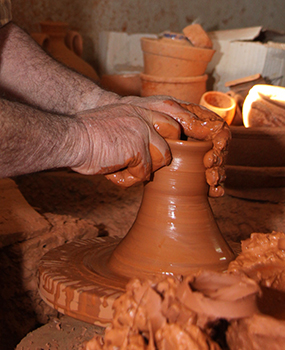 |
To be a potter means having an intrinsic knowledge of clay work, its characteristics, the processes of production and preparation of the feedstock, in the knowledge of rounding and moulding tools, as well as of his own body. To be a potter is an art of specific knowledge, result of the learning with those who teache and of the work experience. To be a potter doesn’t entail (mandatorily) ownership a workshop, since many potters can work under the orders of the workshop’s master.
Similarly to other manual crafts, the transmission of knowledge of the clay preparation and work, and then its modelling, is done through a process of mechanical reproduction of gestures and procedures stemming from a base of generational transmission, which in Viana do Alentejo is enlarged with the creation of the pottery school in 28th October 1893, going beyond the physical limits of the pottery workshop’s pedagogy.
The pottery workshops in Viana do Alentejo have always shown patriarchal structures, where the potter craft is passed on from father to son. This small domestic economy was only altered when the demand for pieces so required, leading the potter to hire daily paid labour.
This familiar dynamic is also visible in the works developed in the pottery scope, which were divided by gender and age: the young apprentice, about 6 years old, began by learning the craft’s bases, following the master in the tasks of gathering, preparation, and then the moulding processes. The master potter is the one in charge with the shop’s management, as well as the more physical jobs, specially the feedstock preparation and the processes of modelling and baking. Until 1982 women were limited to the small tasks; with the emergence of painting their sensibility is channelled to the tasks of preparatory drawing and painting.
When a potter opens a new shop, the same organizational model is applied with a functional matrix that repeats itself in time and space.
In the bridge between Material and Intangible we find the crockery of local production that until 1982 had exclusively a utility function. After this year the decorated crockery in the shops of Viana emerges, with Feliciano Branco Agostinho, in a mixture of his work experiences with his learning in the Médico de Sousa School.
The bases launched by Feliciano Branco Agostinho are the other side of the intangible of Viana’s pottery, with a decorative grammar defined in what is of Viana, and typical of Alentejo: the practices linked to the field and its chores, clothing, local landscapes, associated with colours like brown, in a varied hue of blues and another of ochres, backgrounds normally relegated to the back stage before the lack of perspective and predominance of a naïf drawing

 Abrir Lista
Abrir Lista MUNICÍPIO DE VIANA DO ALENTEJO
MUNICÍPIO DE VIANA DO ALENTEJO